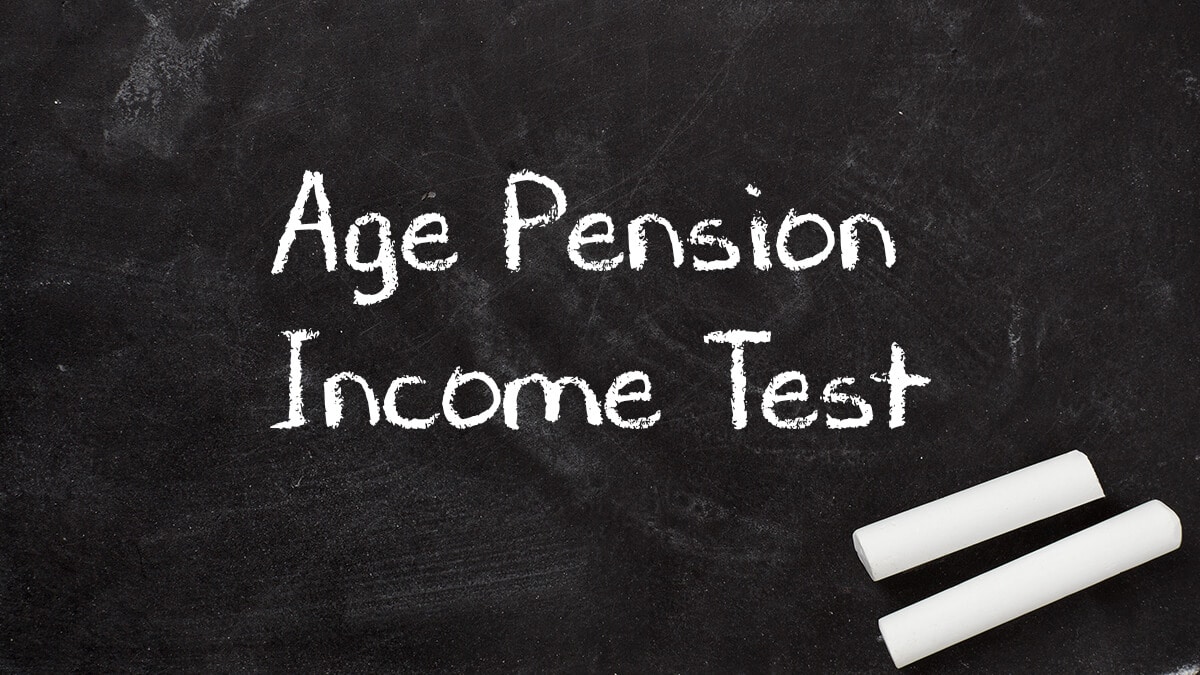In this guide
- How does the Age Pension income test work?
- Age Pension income limits
- Work bonus
- What is included in the Age Pension income test?
- What is not included in the Age Pension income test?
- What if your income changes?
- Means test treatment of lifetime annuities
- Defined benefit super pensions
- How the income and assets tests work together
- Does a mortgage reduce deemed income?
A common question for those nearing, or in, retirement is ‘How much can a pensioner earn before it affects the pension?’. The answer is that it depends on how much income you earn and the total value of your assets, excluding the family home.
This article details the rules of the Age Pension income test, which is one half of the means test used by Centrelink to determine how much Age Pension you could be eligible for.
You must also pass the Age Pension assets test, have reached your eligibility age and satisfy Australian residency rules.
Statistics indicate that the Age Pension income test is passed by fewer Australians than the asset test. According to the Centre of Excellence in Population Ageing Research (CEPAR), approximately two thirds of Australians receiving part pensions have too much income to be eligible for the full pension. The other one third of part-pensioners have too much assessable wealth (assets).
How does the Age Pension income test work?
Centrelink assesses your gross income (that is, your before-tax income) from all sources to determine your eligibility for the Age Pension. These sources include income from overseas, not just Australia. If you have a partner, their income will also be included in your income test assessment.
The current income limits are itemised in the tables below.

Free eBook
Retirement planning for beginners
Our easy-to-follow guide walks you through the fundamentals, giving you the confidence to start your own retirement plans.
"*" indicates required fields
Age Pension income limits
To be eligible for a full Age Pension your income must be below the following thresholds.
Income limits for a full Age Pension
| Situation | Latest fortnightly limit | Latest annual limit* | Previous fortnightly limit | Previous annual limit* | Fortnightly increase | Annual increase* |
|---|---|---|---|---|---|---|
| Single | $218 | $5,668 | $212 | $5,512 | $6.00 | $156 |
| Couple (combined) | $380 | $9,880 | $372 | $9,672 | $8.00 | $208 |
| Couple (illness-separated, combined) | $380 | $9,880 | $372 | $9,672 | $8.00 | $208 |
- Latest limits apply 1 July 2025 to 30 June 2026
- Previous limits apply 1 July 2024 to 30 June 2025
Source: Services Australia. Annual amounts are approximate.
If your income is above the thresholds in the above table, you may still be eligible for a part Age Pension. The table below shows the maximum income you can earn to still be eligible to receive a part pension payment.
The amount of Age Pension for which you are eligible reduces by 50 cents for each dollar earned until it cuts off completely when your income exceeds the figures below.
Income limits for a part Age Pension (residents)
| Situation | Latest fortnightly limit | Latest annual limit* | Previous fortnightly limit | Previous annual limit* | Fortnightly increase | Annual increase* |
|---|---|---|---|---|---|---|
| Single | $2,575.40 | $66,960 | $2,516.00 | $65,416 | $59.40 | $1,544 |
| Couple (combined) | $3,934.00 | $102,284 | $3,844.40 | $99,954 | $89.60 | $2,330 |
| Couple (illness-separated, combined) | $5,095.00 | $132,465 | $4,976.00 | $128,690 | $118.80 | $3,089 |
- Latest limits apply 20 September 2025 to 19 March 2026
- Previous limits apply 1 July 2025 to 19 September 2025
Source: Services Australia
*Annual amounts are approximate.
To illustrate how the Age Pension rate decreases based on how much income you earn, below are some examples of the current Age Pension payments for which Australians should be eligible at a range of different income levels, provided they also meet the other eligibility requirements (age, passing the assets test and Australian residency).
Click each example name to view.
Example 1: Single
| Income | Income | Age Pension | Age Pension | Combined | Combined |
|---|---|---|---|---|---|
| per fortnight | per year | per fortnight | per year | per fortnight | per year |
| $218 | $5,668 | $1,178.70 | $30,646 | $1,396.70 | $36,314 |
| $250 | $6,500 | $1,162.70 | $30,230 | $1,412.70 | $36,730 |
| $500 | $13,000 | $1,037.70 | $26,980 | $1,537.70 | $39,980 |
| $750 | $19,500 | $912.70 | $23,730 | $1,662.70 | $43,230 |
| $1,000 | $26,000 | $787.70 | $20,480 | $1,787.70 | $46,480 |
| $1,250 | $32,500 | $662.70 | $17,230 | $1,912.70 | $49,730 |
| $1,500 | $39,000 | $537.70 | $13,980 | $2,037.70 | $52,980 |
| $1,750 | $45,500 | $412.70 | $10,730 | $2,162.70 | $56,230 |
| $2,000 | $52,000 | $287.70 | $7,480 | $2,287.70 | $59,480 |
| $2,250 | $58,500 | $162.70 | $4,230 | $2,412.70 | $62,730 |
| $2,500 | $65,000 | $37.70 | $980 | $2,537.70 | $65,980 |
Example 2: Couple (combined)
| Income | Income | Age Pension | Age Pension | Combined | Combined |
|---|---|---|---|---|---|
| per fortnight | per year | per fortnight | per year | per fortnight | per year |
| $380 | $9,880 | $1,777.00 | $46,202 | $2,157.00 | $56,082 |
| $500 | $13,000 | $1,717.00 | $44,642 | $2,217.00 | $57,642 |
| $750 | $19,500 | $1,592.00 | $41,392 | $2,342.00 | $60,892 |
| $1,000 | $26,000 | $1,467.00 | $38,142 | $2,467.00 | $64,142 |
| $1,250 | $32,500 | $1,342.00 | $34,892 | $2,592.00 | $67,392 |
| $1,500 | $39,000 | $1,217.00 | $31,642 | $2,717.00 | $70,642 |
| $1,750 | $45,500 | $1,092.00 | $28,392 | $2,842.00 | $73,892 |
| $2,000 | $52,000 | $967.00 | $25,142 | $2,967.00 | $77,142 |
| $2,250 | $58,500 | $842.00 | $21,892 | $3,092.00 | $80,392 |
| $2,500 | $65,000 | $717.00 | $18,642 | $3,217.00 | $83,642 |
| $2,750 | $71,500 | $592.00 | $15,392 | $3,342.00 | $86,892 |
| $3,000 | $78,000 | $467.00 | $12,142 | $3,467.00 | $90,142 |
| $3,250 | $84,500 | $342.00 | $8,892 | $3,592.00 | $93,392 |
| $3,500 | $91,000 | $217.00 | $5,642 | $3,717.00 | $96,642 |
| $3,750 | $97,500 | $92.00 | $2,392 | $3,842.00 | $99,892 |
Example 3: Couple (illness-separated, combined)
| Income | Income | Age Pension | Age Pension | Combined | Combined |
|---|---|---|---|---|---|
| per fortnight | per year | per fortnight | per year | per fortnight | per year |
| $380 | $9,880 | $2,357.40 | $61,292 | $2,737.40 | $71,172 |
| $500 | $13,000 | $2,297.40 | $59,732 | $2,797.40 | $72,732 |
| $750 | $19,500 | $2,172.40 | $56,482 | $2,922.40 | $75,982 |
| $1,000 | $26,000 | $2,047.40 | $53,232 | $3,047.40 | $79,232 |
| $1,250 | $32,500 | $1,922.40 | $49,982 | $3,172.40 | $82,482 |
| $1,500 | $39,000 | $1,797.40 | $46,732 | $3,297.40 | $85,732 |
| $1,750 | $45,500 | $1,672.40 | $43,482 | $3,422.40 | $88,982 |
| $2,000 | $52,000 | $1,547.40 | $40,232 | $3,547.40 | $92,232 |
| $2,250 | $58,500 | $1,422.40 | $36,982 | $3,672.40 | $95,482 |
| $2,500 | $65,000 | $1,297.40 | $33,732 | $3,797.40 | $98,732 |
| $2,750 | $71,500 | $1,172.40 | $30,482 | $3,922.40 | $101,982 |
| $3,000 | $78,000 | $1,047.40 | $27,232 | $4,047.40 | $105,232 |
| $3,250 | $84,500 | $922.40 | $23,982 | $4,172.40 | $108,482 |
| $3,500 | $91,000 | $797.40 | $20,732 | $4,297.40 | $111,732 |
| $3,750 | $97,500 | $672.40 | $17,482 | $4,422.40 | $114,982 |
| $4,000 | $104,000 | $547.40 | $14,232 | $4,547.40 | $118,232 |
| $4,250 | $110,500 | $422.40 | $10,982 | $4,672.40 | $121,482 |
| $4,500 | $117,000 | $297.40 | $7,732 | $4,797.40 | $124,732 |
| $4,750 | $123,500 | $172.40 | $4,482 | $4,922.40 | $127,982 |
| $5,000 | $130,000 | $47.40 | $1,232 | $5,047.40 | $131,232 |
The Age Pension income limits are adjusted three times a year based on movements in the consumer price index (CPI). The thresholds for the full Age Pension change in July, while thresholds for the part Age Pension change in March and September.
2026 SMSF calendar
Our free calendar includes due dates for important documents plus suggested dates for trustee meetings and other strategic issues for your SMSF.
"*" indicates required fields
You can access the latest Age Pension rates here.
Work bonus
Generally, you can earn up to $300 a fortnight if you’re still working and you will not have this amount included in your income test for the Age Pension. This amount is known as a ‘work bonus.’ The work bonus amount can be accumulated up to an amount of $11,800. You don’t need to apply to have this done. Centrelink will apply the work bonus to your income test.
Income limits for a part Age Pension (non-residents)
Be aware that if you’re currently residing outside Australia but are still eligible for an Australian Age Pension, different maximum income test thresholds and payment rates apply for the part pension.
The different maximum income test thresholds are outlined in the table below.
| Situation | Latest fortnightly limit | Latest annual limit* | Previous fortnightly limit | Previous annual limit* | Fortnightly increase | Annual increase* |
|---|---|---|---|---|---|---|
| Single | $2,436.40 | $63,346 | $2,378.60 | $61,844 | $57.80 | $1,503 |
| Couple (combined) | $3,732.80 | $97,053 | $3,645.60 | $94,786 | $87.20 | $2,267 |
| Couple (illness-separated, combined) | $4,816.80 | $125,237 | $4,701.20 | $122,231 | $115.60 | $3,006 |
- Latest limits apply 20 September 2025 to 19 March 2026
- Previous limits apply 1 July 2025 to 19 September 2025
Source: Services Australia
*Annual amounts are approximate.
Income limits for a transitional part Age Pension (residents)
Some Age Pensioners in Australia are on transitional pensions. Transitional pension rates are paid to people who would otherwise be getting a lower payment after changes to the income test were introduced in 2009.
The table below shows the asset value cut-off points for receiving a transitional pension.

Free eBook
Beginners guide to the Age Pension
Learn how the Age Pension is assessed, and how to apply.
"*" indicates required fields
| Situation | Latest fortnightly limit | Latest annual limit* | Previous fortnightly limit | Previous annual limit* | Fortnightly increase | Annual increase* |
|---|---|---|---|---|---|---|
| Single | $2,617.25 | $68,049 | $2,580.00 | $67,080 | $37.25 | $969 |
| Single with one dependent child | $2,641.85 | $68,688 | $2,604.60 | $67,720 | $37.25 | $969 |
| Couple (combined) | $4,251.50 | $110,539 | $4,191.50 | $108,979 | $60.00 | $1,560 |
| Couple (illness-separated, combined) | $5,178.50 | $134,641 | $5,104.00 | $132,704 | $74.50 | $1,937 |
- Latest limits apply 20 September 2025 to 19 March 2026
- Previous limits apply 1 July 2025 to 19 September 2025
Source: Services Australia
*Annual amounts are approximate.
Income limits for a transitional part Age Pension (non-residents)
| Situation | Latest fortnightly limit | Latest annual limit* | Previous fortnightly limit | Previous annual limit* | Fortnightly increase | Annual increase* |
|---|---|---|---|---|---|---|
| Single | $2,385.75 | $62,030 | $2,351.50 | $61,139 | $34.25 | $891 |
| Single with one dependent child | $2,410.35 | $62,669 | $2,376.10 | $61,779 | $34.25 | $891 |
| Couple (combined) | $4,003.00 | $104,078 | $3,946.00 | $102,586 | $57.00 | $1,482 |
| Couple (illness-separated, combined) | $4,715.50 | $122,603 | $4,647.00 | $120,822 | $68.50 | $1,781 |
- Latest limits apply 20 September 2025 to 19 March 2026
- Previous limits apply 1 July 2025 to 19 September 2025
Source: Services Australia
Annual amounts are approximate.
What is included in the Age Pension income test?
You and your partner’s gross income from all sources could include any of the following.
- Any employment income you may have received (excluding the fortnightly work bonus mentioned earlier in this article).
- Any investment income you may have received, including any deemed income from money in super funds if you have reached Age Pension age. Rental income from property investments will be assessed at its actual rate, whereas income from other investments (such as shares, superannuation and bank deposits) will be assessed using Centrelink’s deeming rate of return, regardless of the actual amount of income received.
- Any voluntary super contributions that you may make (or that an employer may make on your behalf that is in excess of the superannuation guarantee). These payments are known as reportable super contributions and are treated as income for the purposes of assessing your eligibility for the Age Pension under the income test. That’s because they are taxed at the concessional super rate of 15% and you can claim them as a tax deduction.
- Any income you may have received from being a sole trader or a partner in a business.
- Certain types of lump sum payments you may have received (for example, leave payments, distributions from family trusts, royalty payments, or severance/redundancy payouts).
If any of the income you or your partner have received is from overseas sources, the amounts will be converted to an equivalent Australian dollar value using current exchange rates.
What is not included in the Age Pension income test?
Income that isn’t assessed as part of the Age Pension income test includes:
- Most government payments
- Regular payments from close relatives
- Some lump sums (such as one-off super payments, gifts, inheritances, insurance payouts, lotto prizes and gambling wins).
What if your income changes?
If you’re receiving the full or part Age Pension, you need to inform Centrelink of any changes to you or your partner’s income within 14 days. This includes both increases and decreases to your income.
Manage your retirement savings with confidence – for free

Get practical guidance from independent experts to help you make the most of your finances in retirement with a free SuperGuide account.
Find out moreCentrelink will then reassess your correct Age Pension entitlement. If you’ve been overpaid the Age Pension since your income has increased, you’ll be required to repay the excess amount. On the other hand, if you’ve been underpaid, you may be reimbursed.
You may also be required to confirm your earnings with Centrelink every 14 days to make sure you’re continuing to be paid the right Age Pension amount.
Means test treatment of lifetime annuities
From 1 July 2019 changes to the means testing of lifetime annuities for the purposes of determining Age Pension entitlements came into force. It’s a complex calculation so you may need independent financial advice.
Defined benefit super pensions
If you’re one of the estimated 10% of Australians receiving a defined benefit super pension, 10% of that income is excluded from the Age Pension income test.
How the income and assets tests work together
If you reach the threshold limits in both the income and assets tests, your pension will be based on the lower amount. For example, if you are eligible for $400 a fortnight according to the assets test, and $500 a fortnight under the income test, then the $400 a fortnight test will apply.
Does a mortgage reduce deemed income?
Q: I have my own home, but with a $200,000 mortgage on it. I also have $375,000 invested in shares. Does the income test assess the deemed income on $375,000 or does it reduce by the home mortgage amount and assess the deemed income on $175,000?
Jacie Taylor, an independent financial adviser from Periapt Advisory in Adelaide, answers our reader question:
The value of the financial assets for deeming purposes in the income test cannot be reduced by the mortgage on the principal place of residence. It seems like you are conflating the issues of assessable assets under the assets test and the value of investments under the income test.

Free eBook
How to maximise your Age Pension
Learn tips that help you make the most of the Age Pension so your retirement savings last longer.
"*" indicates required fields



Leave a Reply
You must be logged in to post a comment.